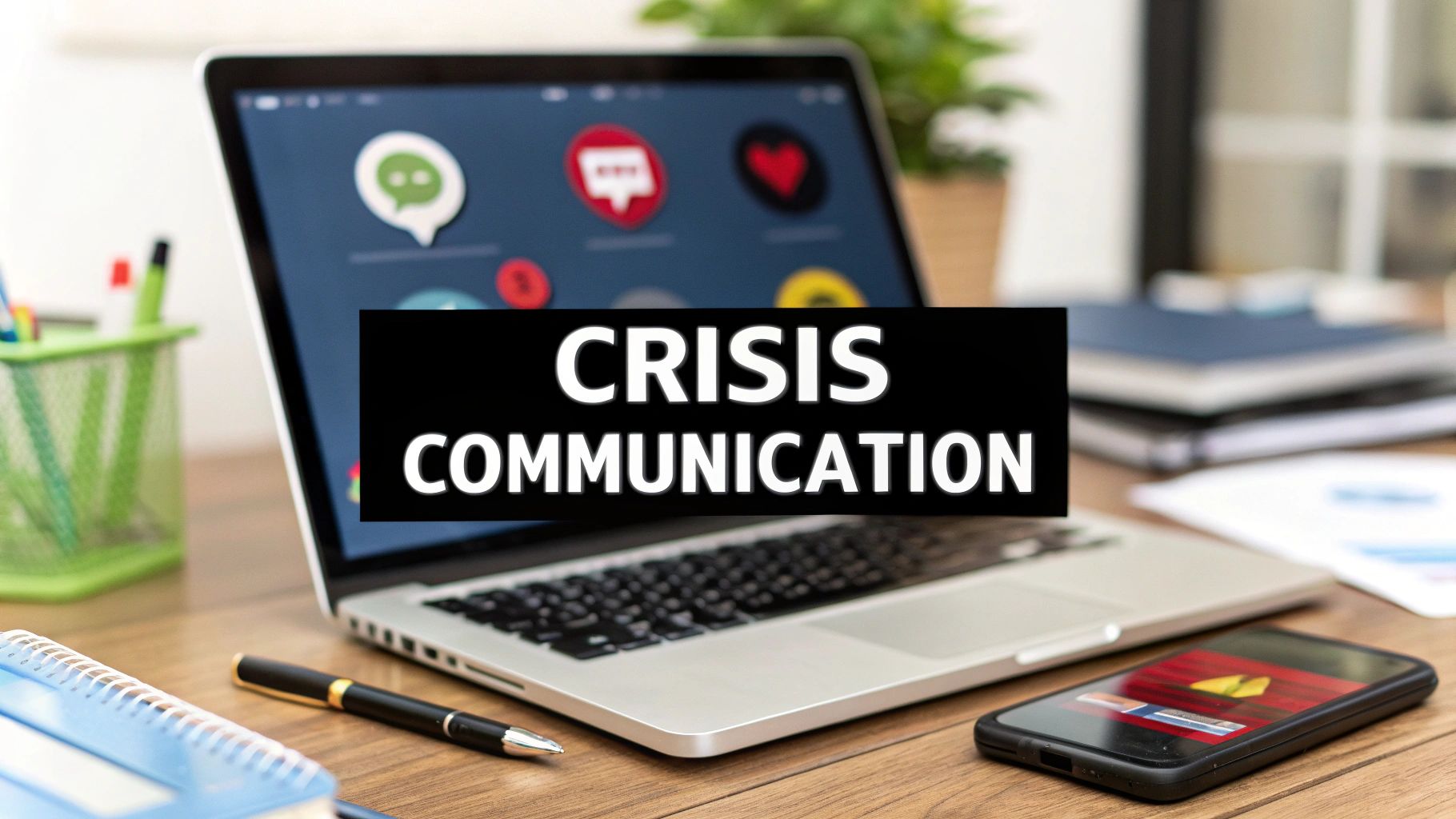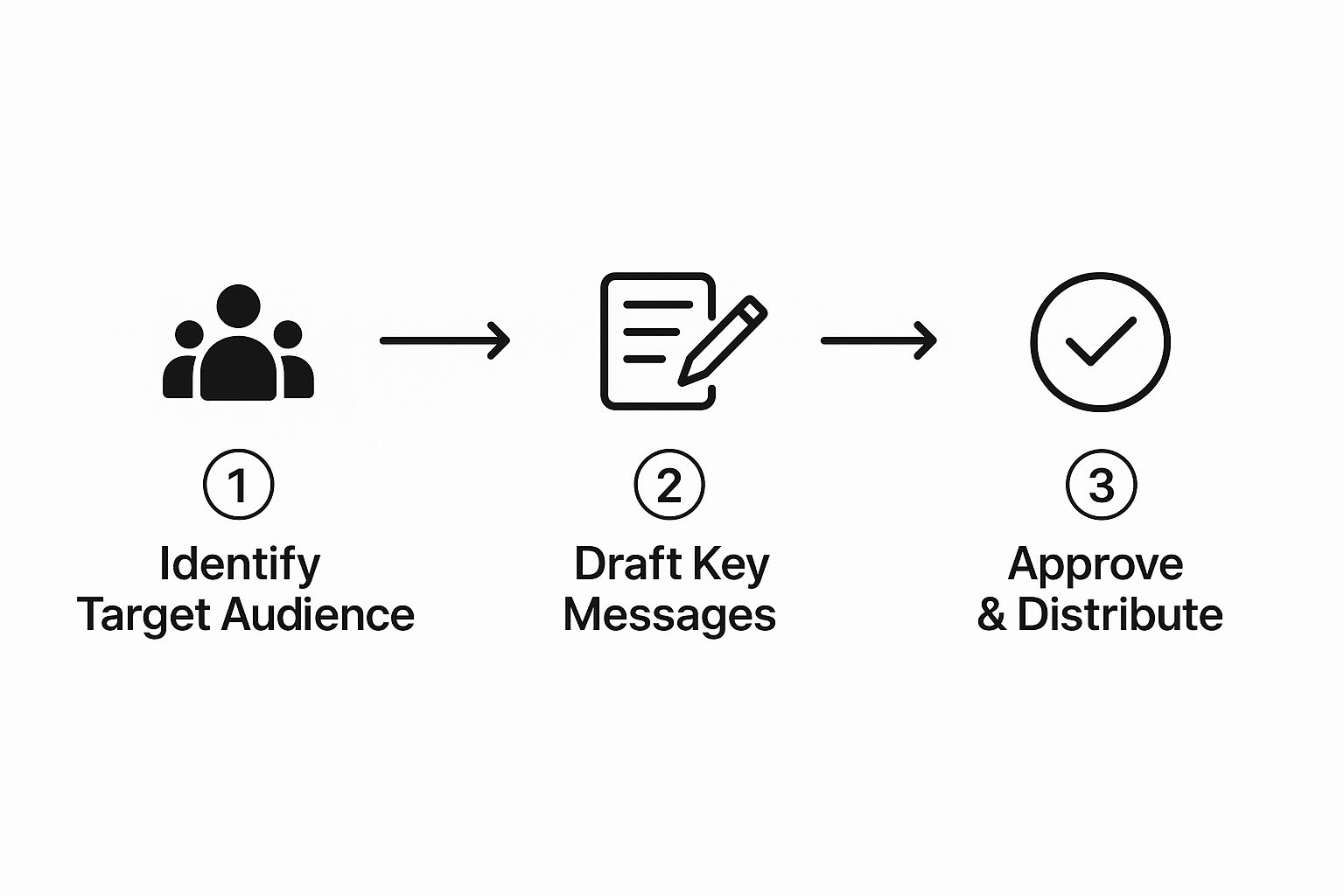Questions & Answers
We're here to help you get the most out of viral.app.
Mike Schneider
Co-Founder
Learn to build a resilient brand by mastering rapid, transparent, and empathetic crisis response on social media.

Let's be honest, social media crisis communication isn't just a fancy PR term anymore. It's the frontline defense for your brand's reputation. This isn't about crafting a perfect, delayed apology. It's about jumping into the fray with speed, honesty, and empathy to manage a story that's already spiraling.
When a single negative post can circle the globe in minutes, having a rock-solid response plan isn't just a good idea—it's essential for survival.
Welcome to the new reality of brand management. Your reputation is no longer shaped in boardrooms; it’s built, challenged, and defended tweet by tweet, comment by comment. Information moves at the speed of a share, and public opinion forms in real-time. This frantic pace has made traditional crisis playbooks almost completely useless.
Today, a "crisis" isn't always a massive corporate scandal. Often, it's something much smaller that catches fire and gains an unstoppable digital momentum.
Picture this: a single, frustrated customer posts a video detailing a bad experience with your product. On its own, that's a customer service ticket. But once the TikTok or X (formerly Twitter) algorithm grabs hold, it can explode, reaching millions and morphing into a full-blown reputational nightmare.
It could be an employee's off-the-cuff mistake, a poorly timed ad, or even a targeted misinformation campaign from a competitor. The game has changed. Your audience isn't just consuming news about you; they’re actively creating and spreading it. User-generated memes, influencer takedowns, and boycott hashtags can hijack the narrative long before your team has even drafted a press release.
The hard truth: The conversation is happening whether you’re part of it or not. A proactive social media crisis plan ensures you're a participant, not a punching bag.
Before we dive into building that plan, it's critical to understand the principles that separate a successful response from a disastrous one. Old-school tactics just don't cut it anymore.
| Principle | What It Looks Like In Action | Why It Matters Today |
|---|---|---|
| Speed Over Perfection | Issuing a quick acknowledgment ("We see this and we're looking into it.") within the first hour. | In the digital age, silence is often interpreted as guilt or incompetence. A fast response buys you time. |
| Radical Transparency | Admitting what you know, what you don't know, and what you're doing to find out. | Audiences can spot a corporate spin a mile away. Honesty, even when it's uncomfortable, builds trust. |
| Humanity and Empathy | Using a personal, human tone. Ditching corporate jargon for genuine language that acknowledges feelings. | People connect with people, not faceless corporations. Showing you understand the human impact is crucial. |
| Action Over Words | Announcing concrete steps you're taking to fix the problem, not just saying you're sorry. | "We're sorry" is empty without "Here's what we're doing to make it right and ensure it never happens again." |
| Meeting Them Where They Are | Responding directly on the platform where the crisis started, not trying to redirect to a press release. | You must engage in the native environment of the conversation. It shows you're not trying to hide or control the narrative. |
Embracing these principles is the foundation of a resilient brand in 2024. They guide every decision you'll make when the pressure is on.
Waiting for a fire to start before you buy an extinguisher is a recipe for disaster. The same goes for a social media crisis. Trying to build a plan in the middle of chaos is a guaranteed way to fail, as panic clouds judgment and forces costly mistakes.
A plan, developed during peacetime, gives your team the clarity and confidence they need when it matters most. It clearly defines who’s in charge, what needs to be said, where to say it, and how to track the fallout.
This preparation goes beyond just pre-writing a few "we're sorry" templates. It's about knowing what your normal online chatter looks like so you can spot the weird stuff immediately. Regularly monitoring key social media engagement metrics is your early-warning system. It’s what helps you tell the difference between a few grumpy customers and the first tremors of a genuine crisis.
Let's be honest—the absolute worst time to figure out your crisis strategy is when your social media mentions are already on fire. When the pressure is on and people are demanding answers, you’re far more likely to make a panic-driven mistake.
That’s why a pre-crisis playbook is your single best defense. It turns potential chaos into a structured, manageable response. Think of it as building muscle memory for your team. You do the heavy lifting now so you can execute with precision later, not frantic energy.
First things first: who needs to be in the war room when a crisis hits? This isn't a job for a lone social media manager. You need a cross-functional team with crystal-clear roles.
Your go-to team should include:
My biggest tip: Create a contact sheet with 24/7 availability for everyone on this team. A crisis won’t wait for 9-to-5, and neither can you.
While you can't predict every crisis, you can prepare foundational messaging that gets you 90% of the way there. This is where you define your brand's tone for tough times—it should be empathetic, transparent, and direct.

Having this approval flow mapped out ahead of time is a game-changer. It cuts through the confusion and bottlenecks when every second is critical. If you need a solid framework to get started, this crisis communication plan example is a great resource.
Get started by drafting a few core templates:
These pre-approved templates are massive time-savers. They let your team focus on gathering the facts and tailoring the message, instead of trying to write a masterpiece from scratch under immense pressure.

To really get what’s at stake with modern crisis management, you have to understand the sheer, brutal speed of social media. We're not just talking about communication channels anymore. Platforms like TikTok and X (what used to be Twitter) are basically accelerators for bad news.
A single misstep, one poorly-worded post, or an ignored customer complaint can spark a global firestorm. And your brand will be right in the middle of it. The platform algorithms, which are built to maximize engagement, often grab onto sensational, emotional, and negative content, pushing it right to the top of everyone’s feed.
A digital crisis doesn't build slowly; it detonates. The initial event is just the spark. The real, lasting damage comes from the waves of user-generated content, influencer pile-ons, and media feeding frenzy that follow.
It’s terrifying how fast things can escalate. One minute you have an isolated issue; the next, you’re dealing with:
The result? You lose control of the narrative almost instantly. Public perception is set in stone by the fastest voices, not the most accurate ones.
We’ve seen this play out time and time again. Social media platforms act as crisis accelerators, allowing content to go viral in minutes and shaping public opinion before the full context is even known.
Take the OceanGate Titan submersible disaster in 2023. While the company struggled to provide timely updates, TikTok and X were flooded with memes, speculation, and panicked theories. Misinformation completely dominated the narrative.
Volkswagen learned this the hard way, too, when a prank kidnapping teaser video went viral on Instagram. The brand's delay in deleting it only fueled the fire, leading to even wider circulation of the harmful content. It's a textbook example of how a poor social media response can pour gasoline on a reputational crisis.
The key takeaway is this: Once misinformation or a negative narrative takes hold, it's incredibly difficult to erase. The story is written by whoever gets there first.
This is exactly why a reactive approach is a recipe for disaster. Your crisis communication plan has to be built for speed. To prevent a small fire from becoming an uncontrollable blaze, you need proactive and responsive customer care on social media. Building out effective social media customer care strategies is your best frontline defense.
When a crisis hits, those first 60 minutes are everything. This is your "golden hour"—that critical window where your immediate actions can either start putting out the fire or pour gasoline on it. In the world of social media, the clock ticks incredibly fast, and silence is interpreted as guilt.
Your goal right now isn't to have all the answers. Honestly, you won't. The real objective is to show up, prove you're listening, and communicate that you're taking action. A quick, public acknowledgment is non-negotiable.
Something as simple as, "We're aware of the situation and are looking into it right now," can buy you an incredible amount of breathing room and goodwill. It’s a basic move, but it signals you're not hiding. It tells your audience you take their concerns seriously. Without it, you create a vacuum that will instantly fill with speculation, anger, and misinformation.
Once that initial message is out, your next move is to wrangle the information flow on your own turf. This is where you establish a single source of truth for everyone watching—customers, press, and stakeholders.
Here’s how to use your platforms to own the narrative:
This strategy funnels everyone to one place, making it easy for people to get official information directly from you. It actively starves rumors of the oxygen they need to spread.
The goal is to become the most reliable source of information about your own crisis. If you don't define the situation, others will, and you won't like their definition.
In a crisis, corporate jargon is poison. People want to hear from other people. This is where authenticity and empathy become your most valuable assets. Forget the polished press release; a straightforward, unscripted video from your CEO or a series of clear, human-to-human statements can do far more to steer the conversation.
The Target data breach is a classic case study in getting this right. When the news broke that millions of customers' credit card details had been compromised, Target's CEO didn't wait. He was on social media within hours with a video message. He expressed genuine regret and, more importantly, immediately detailed the concrete steps they were taking to help, including offering free identity protection services.
That rapid, human response helped them manage a situation that could have been a complete reputational catastrophe. You can find more case studies about brand crisis responses to see how other modern brands have navigated these choppy waters.

Once the immediate storm has passed, the real work begins. Effective social media crisis communication isn't just about damage control; it’s about what you do next. This is a rare chance to learn, adapt, and come out stronger. You’re shifting from a reactive defense to a proactive rebuild.
The very first thing to do is hold a frank and comprehensive post-mortem. Get your crisis team in a room—not to point fingers, but to dissect every part of your response with total honesty. Think of it less as a meeting and more as an essential intelligence-gathering exercise.
Your review needs to be data-driven and brutally honest. You have to pinpoint what worked, what didn't, and where your pre-planned processes either held up or fell apart under pressure. Gut feelings won't cut it. It's time to dig into the metrics.
Get your team to answer these critical questions:
This deep dive gives you the raw material needed to fortify your crisis plan. In fact, one study found that brands that respond to a crisis and show accountability can see a 20% increase in value. Those that stay silent? They risk a 15% drop.
The goal isn't just to review the last crisis but to prepare for the next one. Every mistake is a lesson, and every successful tactic is a new tool in your arsenal.
With the insights from your post-mortem, you can start the long-term work of rebuilding trust. This phase demands patience and consistency. You can't just go back to business as usual and hope everyone moves on. They won't.
Your recovery strategy should zero in on two key areas: proactive positive engagement and continuous sentiment monitoring. Start creating and sharing content that reinforces your brand values and your commitment to your customers. Highlight positive stories, offer behind-the-scenes looks at the improvements you’re making, and actively participate in community-building conversations.
At the same time, keep a close watch on your brand sentiment. Social listening tools, like the advanced analytics dashboard provided by viral.app, are your best friend here. Track mentions and keywords related to the crisis. Is the negative chatter dying down? Is positive sentiment starting to trend upward? A detailed breakdown of your metrics is non-negotiable. You can learn more about building out effective social media campaign reporting to track this progress with precision.
By meticulously analyzing your performance and showing a genuine commitment to getting better, you turn a negative event into a powerful catalyst. You prove to your audience that you listen, you learn, and you care—building a much more resilient and respected brand in the process.
When a social media crisis is unfolding, the big-picture strategy can get lost in a series of urgent, tactical questions. These are the in-the-moment decisions that feel impossible to make under pressure. Let's tackle the most common questions teams face, head-on.
Almost never. I know the impulse is to clean up your page, but deleting negative comments is one of the fastest ways to pour fuel on the fire.
People take screenshots. The narrative immediately flips from your original mistake to accusations of censorship and a cover-up. It's a guaranteed way to erode trust.
The only time you should even think about deleting a comment is if it clearly violates your established community policy. This means things like:
For legitimate criticism—even when it's harsh—transparency is your best play. Acknowledge the comment and professionally point them to your official statement. This shows you're not hiding.
Focus your main, detailed response on the platform where the crisis is hottest. If the issue blew up on X (formerly Twitter), that's your command center. Use it for your most frequent and in-depth updates.
That said, you have to acknowledge the situation on all your active channels. Post a brief, unified statement on your other platforms—like Instagram, Facebook, and LinkedIn. Confirm you're aware of the issue and drop a direct link to your primary response channel for the latest information.
This strategy is non-negotiable. It ensures you have a consistent message across your entire digital footprint and centralizes the conversation, making it easier for everyone—your audience, the media—to find official updates.
Your employees can be either your greatest advocates or a huge liability. Their role needs to be defined long before a crisis ever hits.
You absolutely need a clear internal social media policy. Before you make your first public statement, brief your entire team. Give them a simple summary of the situation and an approved, shareable message they can use if they choose to.
The critical instruction: tell them not to speculate, offer personal opinions, or engage with negativity from their personal accounts. One well-meaning but uninformed employee can accidentally spread rumors or post something that torpedoes your company's credibility.
When you get it right, an informed team can be a powerful amplifier for your official message. This is also why some brands look to a controlled approach with influencers, though that requires careful management. To get a better sense of the pros and cons, you can explore the ROI of influencer marketing and see how it might fit into a broader communications plan.
Ready to protect your brand with best-in-class tracking and analytics? viral.app gives you the power to monitor your social presence on TikTok, Instagram Reels, and YouTube Shorts, so you can spot potential issues before they become crises. Discover how viral.app can safeguard your reputation today.
We're here to help you get the most out of viral.app.
Become an expert in UGC marketing today leveraging our industry knowledge and unique tools.